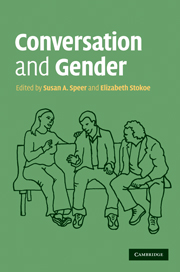Book contents
- Frontmatter
- Contents
- Contributors
- Data and transcription
- 1 An introduction to conversation and gender
- Part I Gender, person reference and self-categorization
- Part II Gender, repair and recipient design
- 5 ‘Girl – woman – sorry!’: On the repair and non-repair of consecutive gender categories
- 6 Gender, routinization and recipient design
- 7 Recipients designed: Tag questions and gender
- Part III Gender and action formation
- Part IV Gender identities and membership categorization practices
- References
- Author index
- Subject index
5 - ‘Girl – woman – sorry!’: On the repair and non-repair of consecutive gender categories
Published online by Cambridge University Press: 05 June 2012
- Frontmatter
- Contents
- Contributors
- Data and transcription
- 1 An introduction to conversation and gender
- Part I Gender, person reference and self-categorization
- Part II Gender, repair and recipient design
- 5 ‘Girl – woman – sorry!’: On the repair and non-repair of consecutive gender categories
- 6 Gender, routinization and recipient design
- 7 Recipients designed: Tag questions and gender
- Part III Gender and action formation
- Part IV Gender identities and membership categorization practices
- References
- Author index
- Subject index
Summary
Introduction
This chapter examines how speakers make and repair consecutive references to third parties using the gender categories ‘girl’, ‘woman’ and ‘lady’, within the context of debates about when and how gender is relevant in talk. The chapter starts with a brief summary of language and gender research, before moving on to explain the practices of ‘repair’ and ‘person reference’ in conversation analysis. The analysis focuses on instances of ‘same-turn’ or ‘self-initiated self-repair’ (Schegloff, 1979; Schegloff et al., 1977), in which a speaker marks some aspect of their ongoing talk as problematic and repairs it within the same turn (e.g., ‘that girl over – that woman over there’). This is in contrast to other types of repair in which recipients initiate and produce repair. Four analytic sections focus on a particular format of ‘XY’ repairs, in which X is a first gender category and Y is another. The first section examines canonical XY repairs; the second focuses on cases in which the repair segment contains a marked orientation to the repairable. The third section examines cases in which ‘or’ is a feature of the repair segment. The final section focuses on instances of consecutive alternative reference where no features of repair are present. Both the third and fourth sections therefore consider cases of probable non-repair, or ‘doing’ non-repair. Overall, the chapter considers how different formats for producing consecutive alternate gender categories display speakers' ‘commitment’ to one category or the other, and their relevance for evidencing speakers' ‘orientation to gender’.
- Type
- Chapter
- Information
- Conversation and Gender , pp. 85 - 111Publisher: Cambridge University PressPrint publication year: 2011
- 13
- Cited by

